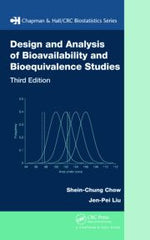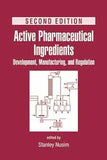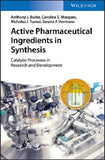Design and Analysis of Bioavailability and Bioequivalence Studies, Third Edition by Shein-Chung Chow, Jen-pei Liu
Design and Analysis of Bioavailability and Bioequivalence Studies, Third Edition
Features
- Encompasses the vast amount of recent research activities, regulations, and scientific breakthroughs in bioavailability and bioequivalence
- Explores the key topics of sample size determination, meta-analysis, and pharmacokinetics
- Presents the current status of regulations on bioavailability and bioequivalence, including guidelines/guidances issued by the FDA, EMEA, and WHO
- Addresses frequently asked concerns, such as the results of failing certain criteria and inconsistency in designs
- Describes relevant SAS programs in an appendix
- Emphasizes practical concepts through numerous examples and illustrations
Summary
Preeminent Experts Update a Well-Respected Book
Taking into account the regulatory and scientific developments that have occurred since the second edition, Design and Analysis of Bioavailability and Bioequivalence Studies, Third Edition provides a complete presentation of the latest progress of activities and results in bioavailability and bioequivalence on regulatory requirements, scientific and practical issues, and statistical methodology.
New to the Third Edition
- Four new chapters that present a thorough account of novel developments in the field
- New and updated sections that reflect recent advances in the statistical methodology in the design and analysis of bioavailability and bioequivalence studies
- Reorganization of the material into five parts, making it easier to access related information together
- Over 100 new references from the literature
Like its bestselling predecessors, this edition covers all of the statistical problems that may occur in the various stages of design and data analysis. Keeping the mathematics and statistics at a fundamental level, it continues to focus on practical concepts rather than technical details.
Table of Contents
Preface
Preliminaries
Introduction
History of Bioavailability Studies
Formulation and Routes of Administration
Pharmacokinetic Parameters
Clinically Important Differences
Assessment of Bioequivalence
Decision Rules and Regulatory Aspects
Statistical Considerations
Aims and Structure of the Book
Design of Bioavailability Studies
Introduction
The Study Objectives
Basic Design Considerations
The Parallel Design
The Crossover Design
The Balanced Incomplete Block Design
The Selection of Design
Statistical Inference for Effects from a Standard 2 × 2 Crossover Design
Introduction
The Carryover Effect
The Direct Drug Effect
The Period Effect
The Analysis of Variance
An Example
Average Bioequivalence
Statistical Methods for Average Bioequivalence
Introduction
The Confidence Interval Approach
The Methods of Interval Hypothesis Testing
Bayesian Methods
Nonparametric Methods
Discussion and Other Alternatives
Power and Sample Size Determination
Introduction
Hypotheses and Type I and Type II Errors
Power and Relative Efficiency
Sample Size Determination
Transformation and Analysis of Individual Subject Ratios
Introduction
Multiplicative (or Log-transformation) Model
Bioequivalence Measures
Maximum Likelihood Estimator
Minimum Variance Unbiased Estimator
Mean of Individual Subject Ratios
Ration of Formulation Means
Comparison of MLE, MVUE, MIR, and RM
An Example
Discussion
The Assessment of Inter- and Intrasubject Variabilities
Introduction
Variability and Decision Making
Point and Interval Estimates
Test for Equality of Variabilities
Equivalence in Variability of Bioavailability
CV Assessment
Discussion
Assumptions of Outlier Detection for Average Bioequivalence
Introduction
Tests for Assumptions
The Definition of Outlying Observations
Detection of Outlying Subjects
Detection of Outlying Observations
Discussion
Optimal Crossover Designs for Two Formulations for Average Bioequivalence
Introduction
Balaam’s Design
The Two-Sequence Dual Design
Optimal Four-Period Designs
Transformation and Individual Subject Ratios
Sample Size for Higher-Order Crossover Designs
Discussion
Assessment of Average Bioequivalence for More Than Two Formulations
Introduction
Assessment of Average Bioavailability with More Than Two Formulations
Analyses for Williams Designs
Analysis for Balanced Incomplete Block Design
Discussion
Population/Individual Bioequivalence
Population and Individual Bioequivalence
Introduction
Limitation of Average Bioequivalence
Merits of Individual Bioequivalence and Desirable Bioequivalence Criteria
Measures of Discrepancy
Probability-Based Criteria
Moment-Based Criteria
Relations among Criteria
Bioequivalence Limits
Designs for Population and Individual Bioequivalence
Discussion
Statistical Procedures for Assessment of Population and Individual Bioequivalence
Introduction
Estimation Procedures
Procedures for Moment-Based Criteria
Procedures for Probability-Based Criteria
Procedures for Evaluation of Population Bioequivalence
Discussion
In Vitro and Alternative Evaluation of Bioequivalence
Assessment of Bioequivalence for Drugs with Negligible Plasma Levels
Introduction
Design and Clinical Endpoints
Statistical Considerations
Weighted Least Squares Methods
Log-linear Models
Generalized Estimating Equations (GEE)
Analysis of Time to Onset of a Therapeutic Response
Discussion
In Vitro Bioequivalence Testing
Background
Regulatory Requirement
Profile Analysis
Nonprofile Analysis
An Example
Discussion
In Vitro Dissolution Profiles Comparison
Introduction
Criteria for Assessment Similarity between Dissolution Profiles
Estimation and Hypothesis Testing Based on f1 and f2
An Example
Discussion
Other Bioequivalence Studies
Meta-analysis for Bioequivalence Review
Introduction
Meta-Analysis for Average Bioequivalence
Alternative Method for Meta-Analysis
Efficiency of Meta-Analysis
Discussion
Population Pharmacokinetics
Introduction
Compartment model
Inter- and Intrasubject Variabilities
Nonlinear Modeling
NOMEN
Discussion
Evaluation of Dose Proportionality, Steady State, and Food Effects
Introduction
Drug Interaction Studies
Assessment of Dose Proportionality
Estimation of Steady State
Evaluation of Food Effects
Evaluation of Bioequivalence of Fixed-Combination Drug Products
Discussion
Review of FDA Guidances
Introduction
Guidance on Conjugated Estrogen Tablets
Guidance on General Considerations
Guidance on Statistical Procedures
Guidance on Nasal Aerosols and Nasal Spray for Local Action
Guidance on Scale-up and Postapproval Changes
Discussion
Some Related Issues and Future Challenges
Introduction
Assessment of Bioequivalence with Genomic Data
Bridging Bioequivalence Studies
Evaluation of Bioequivalence for Biological Products
Medical Device Equivalence
Post-approval Manufacturing Equivalence
Discussion
References
Appendices
Index


















